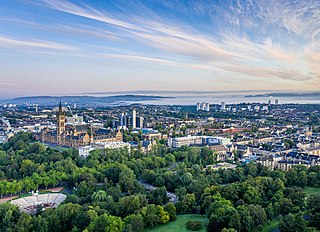
Glasgow is the most populous city in Scotland and the fourth-most populous city in the United Kingdom, as well as being the 27th largest city by population in Europe. In 2020, it had an estimated population of 635,640. Straddling the border between historic Lanarkshire and Renfrewshire, the city now forms the Glasgow City Council area, one of the 32 council areas of Scotland, and is governed by Glasgow City Council. It is situated on the River Clyde in the country's West Central Lowlands.

Maryhill is an area of the City of Glasgow in Scotland. Maryhill is a former burgh. Maryhill stretches over 7 miles (11 km) along Maryhill Road.
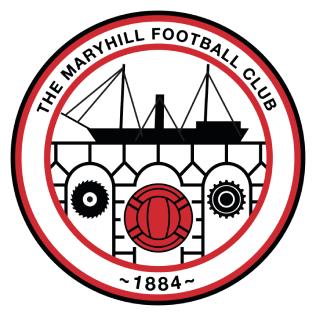
Maryhill Football Club are an association football team based in the Maryhill area of Glasgow, Scotland. The team is a member of the Scottish Junior Football Association, now playing in the West of Scotland Football League Second Division in the 2022-23 season.
Red Clydeside was the era of political radicalism in Glasgow, Scotland, and areas around the city, on the banks of the River Clyde, such as Clydebank, Greenock, Dumbarton and Paisley, from the 1910s until the early 1930s. Red Clydeside is a significant part of the history of the labour movement in Britain as a whole, and Scotland in particular.

Scotstoun is an area of Glasgow, Scotland, west of Glasgow City Centre. It is bounded by Garscadden and Yoker to the west, Victoria Park, Jordanhill and Whiteinch to the east, Jordanhill to the north and the River Clyde to the south. At the heart of Scotstoun lies Scotstounhill, an enclave of late Victorian and post-war housing centred on Scotstounhill railway station. Scotstoun is home to BAE Systems Surface Ships, and to the Glasgow Warriors rugby team.

Castlemilk is a district of Glasgow, Scotland. It lies to the far south of the city centre, adjacent to the Croftfoot and Simshill residential areas within the city to the north-west, the town of Rutherglen - neighbourhoods of Spittal to the north-east and Fernhill to the east, Linn Park and its golf course to the west, and the separate village of Carmunnock further south across countryside.

Kelvindale is a district in the West End of the city of Glasgow, Scotland. Kelvindale shares the G12 postcode with the neighbouring residential districts of Kelvinside, Hillhead, Hyndland, Dowanhill, as well as Gartnavel General Hospital, Glasgow Clyde College (Anniesland) and the University of Glasgow, and is also close to the Anniesland and Wyndford areas of the city. The area is characterised by traditional interwar housing, formed of tenements and semi-detached houses.

North Kelvinside is a residential district of the Scottish city of Glasgow.
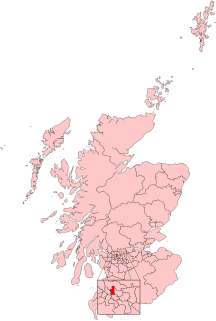
Glasgow North is a burgh constituency of the House of Commons of the Parliament of the United Kingdom. It elects one Member of Parliament (MP) by the first-past-the-post voting system.
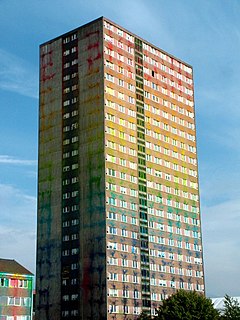
Toryglen is a district in southern Glasgow, Scotland, falling within the Langside ward under Glasgow City Council. It is approximately two miles south of the city centre, bounded to the west by Mount Florida, the north-west by Polmadie, to the north-east by the West Coast Main Line railway and the M74 motorway the south by King's Park, and immediately to the east by the town of Rutherglen.

Milton is a district in the Scottish city of Glasgow, situated north of the River Clyde. The housing scheme is about 2+1⁄2 miles north of Glasgow City Centre and forms part of the northern edge of the city's urban area.

Ruchill is a district in the city of Glasgow. It lies within the Canal Ward of North Glasgow in the Ruchill Community Council area between the Maryhill and Possilpark areas of the city. It has traditionally been characterised by a high degree of deprivation and social problems. However, from the late 1990s much of the poorer-quality housing stock has been cleared to be replaced by newly built housing association and owner-occupied homes, improving much of the area's character.
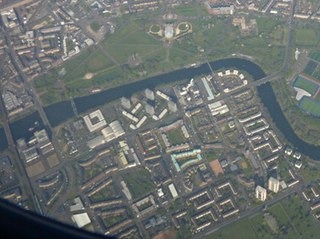
Hutchesontown is an inner-city area in Glasgow, Scotland. Mostly residential, it is situated directly south of the River Clyde and forms part of the wider historic Gorbals district, which is covered by the Southside Central ward under Glasgow City Council.
Muirhouse is a housing estate in the north of Edinburgh, the capital of Scotland.

Duke Street is a street in Glasgow, Scotland. It runs from the city centre to the East End, from High Street through the residential district of Dennistoun, past The Forge Shopping Centre, meeting the Gallowgate, Tollcross Road and Westmuir Street to form a turreted Edwardian junction at Parkhead Cross. It takes its name from the Duke of Montrose.

Bob Doris is a Scottish National Party (SNP) politician. He has served as the Member of the Scottish Parliament (MSP) for Glasgow Maryhill and Springburn since the 2016 Scottish Parliament election, having previously served as an MSP for Glasgow from 2007 to 2016.

Glasgow, the largest city in Scotland, has several distinct styles of residential buildings, and since its population began to grow rapidly the 18th century has been at the forefront of some large-scale projects to deal with its housing issues, some of which have been assessed as being largely successful and others less so.
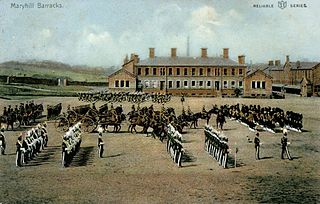
Maryhill Barracks was built on 12 hectares of the Ruchill estate, in the Maryhill area of northern Glasgow, Scotland.

Maryhill is one of the 23 wards of Glasgow City Council. It was created in 2007 as Maryhill/Kelvin, and in that election it returned four council members, using the single transferable vote system. The same boundaries were used in 2012. For the 2017 Glasgow City Council election, the boundaries were changed, the ward substantially decreased in territory and population, was renamed Maryhill and returned three members.

Public housing in the United Kingdom, also known as council estates, council housing, or social housing, provided the majority of rented accommodation until 2011 when the number of households in private rental housing surpassed the number in social housing. Houses and flats built for public or social housing use are built by or for local authorities and known as council houses, though since the 1980s the role of non-profit housing associations became more important and subsequently the term "social housing" became more widely used, as technically council housing only refers to housing owned by a local authority, though the terms are largely used interchangeably. Before 1865, housing for the poor was provided solely by the private sector. Council houses were built on council estates, known as schemes in Scotland, where other amenities, like schools and shops, were often also provided. From the 1950s, blocks of flats and three-or-four-storey blocks of maisonettes were widely built, alongside large developments of terraced housing, while the 1960s and to some degree the 1970s saw construction of many high-rise tower blocks. Flats and houses were also built in mixed estates.



















